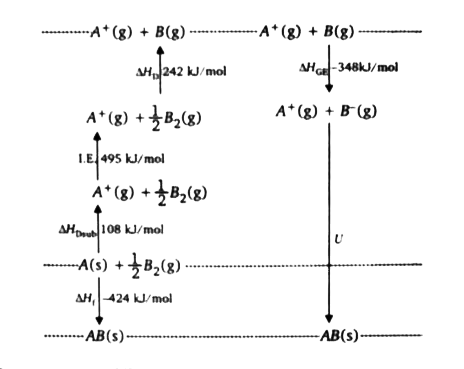Explain the Born-Haber Cycle.
OR
Lattice Enthalpy.
Lattice Enthalpy : The lattice enthalpy of an ionic compound is the enthalpy change which occurs when one mole of an ionic compound dissociates into its ions in gaseous state.
Na+CI−(s)→Na+(g)+CI−(g)
ΔlatticeHΘ=+788 kj/mol
Difference steps of formation of Na Cl and its related enthalpy can be explained by BornHaber cycle as below.
(1) Na(s)→Na((g)), sublimation of sodium
ΔsolHΘ=108.4kj mol−1
(2) Ionization enthalpy,
Na(g)→Na+(g)+e−1(g),ΔiHΘ=496 kj/mol
(3) The dissociation of chlorine, the reaction enthalpy is half the bond dissociation enthalpy.
12CI2(g)→CI(g),12ΔbondHΘ=121 kj/mol
(4) The electron gained enthalpy,
CI(g)+e−→CI−(g),ΔegHΘ=−348.6 kj/mol
(5) Na+(g)+CI−(g)→Na+CI−(s),ΔUHΘ=(?)
(6) Enthalpy of formation of NaCl,
Na(s)+12CI2(g)→NaCI(s),ΔfHΘ=+411.2 kj/mol
Applying Hess.s law, we get,
ΔlatticeHΘ=ΔfHΘ+ΔsHΘ+12ΔbondHΘ+ΔiHΘ+ΔegHΘ
=411.2+108.4+121+496−348.6
=+788 kj
For NaCI(s)→Na+(g)+CI−(g) internal energy is smaller by 2RT and is equal to +783 kj mol−.
Now we use the value of lattice enthalpy to calculate enthalpy of solution from the expression :
ΔsolHΘ=ΔlatticeHΘ+ΔhydHΘ
For one mole of NaCI(s), lattice enthalpy =+788 kj/mol and
∴ΔhydHΘ=−784 kj/mol
∴ΔsolHΘ=+788−784=+4 kj/mol
The dissolution of NaCl(s) is accompanied by very little heat change.

Figure : Enthalpy diagram for lattice enthalpy of NaCl
Topper's Solved these Questions
- THERMODYNAMICSBOOK - KUMAR PRAKASHANCHAPTER - THERMODYNAMICSEXERCISE - Section - A Questions ( 6.6 Spontaneity )
4 Videos
- THERMODYNAMICSBOOK - KUMAR PRAKASHANCHAPTER - THERMODYNAMICSEXERCISE - Section - A Questions ( 6.7 Gibbs Energy Change and Equilibrium )
1 Videos
- THERMODYNAMICSBOOK - KUMAR PRAKASHANCHAPTER - THERMODYNAMICSEXERCISE - Section - A Questions (6.2 Applications)
8 Videos
- THE s-BLOCK ELEMENTSBOOK - KUMAR PRAKASHANCHAPTER - THE s-BLOCK ELEMENTSEXERCISE - Section-D NCERT Exemplar Solution (Long Answer Type)
8 Videos
Similar Questions
Calculate value of -U/100, for AB(s), from following data of Born-Haber's cycle. [where U is lattice energy in kJ/mol]

View SolutionCalculate the lattice enthalpy of KCl from the following data by Born- Haber's Cycle.
Enthalpy of sublimation of K=89kJmol–1
Enthalpy of dissociation of Cl=244kJmol–1
Ionization enthalpy of potassium = 425kJmol–1
Electron gain enthalpy of chlorine = –355kJmol–1
Enthalpy of formation of KCl=–438kJmol−1
View Solution
Knowledge Check
In the Born- Haber calculation of the lattice enthalpy of LiF from its elements , which process is exothermic?
ADissociation energy of F2(g)Belectron gain enthalpy of F(g)Cionization ebergy of Li(g)Dsublimation erergy of Li(s)The Born-Haber cycle is used to determine
Aionization enthalpyBelectron gain enthalpyClattic enthalpyDbond enthalpyBorn-Haber cycle is used to determine
AElectronegativityBLattice energyCBothDNone
Born-Haber cycle is used to determine
View SolutionEnthalpy and Bond Enthalpy | Resonance Energy | Born - Haber cycle | Standard enthalpy of Hydrogenationanad Polymerisation Questions
View SolutionBorn-Haber cycle is used to determine -
View SolutionBorn-Haber cycle is used to determine
View SolutionAssertion:Born-Haber cycle is based on Hess's law.
Reason: Lattice enthalpy can be calculated by Born-Haber cycle
View Solution
